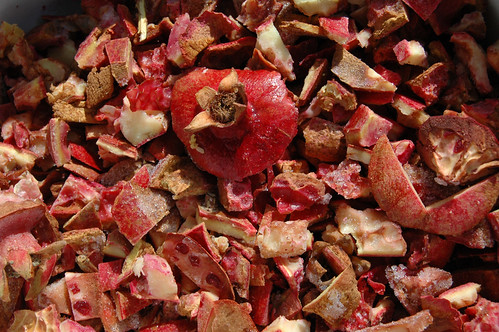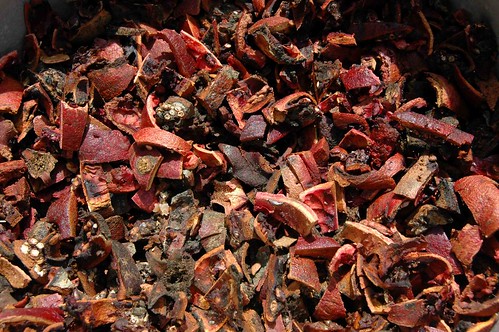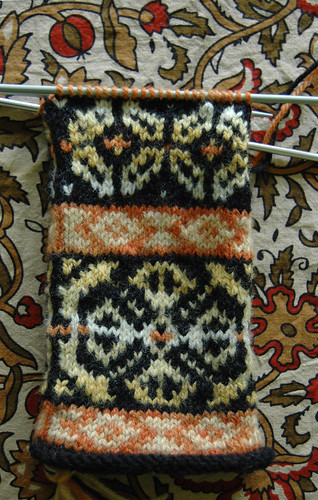Locally Collected Natural Dyes
...

Earlier this winter I asked blog reading friends if they had any access to dye-plants, and I really scored on pomegranates! John and Diane gave me a huge box of pomegranates from their own trees. Robb and I feasted on the fruits, and we shared them with my co-workers. We all improved our pomegranate-peeling skills. And I stashed all the skins in my freezer.

Then a couple of weeks back I was over at Allie's house, and she said that I could help myself to the dried out pomegranate husks under her tree. I loaded up a couple of grocery bags full.
This past weekend, I chopped up these various skins, with the goal of turning them into dye. The frozen skins were nice and clean, while the dried skins were full of mold and not a few spiders.
I decided to test the two types of skins, to see if there were any differences. I used a pound of skins in each dyepot. The dried skins were unsurprisingly much denser. When I boiled the two pots, the dried skins exuded a deep, clear brownish liquid, while the frozen skins produced a sludgy tan soup.
I boiled the skins, turned off the heat, and let the brews steep overnight. The next day, I strained out the skins, which I added to my compost pile. Then I added a two-ounce skein of pre-wetted wool to each pot, raised the temperature to a simmer, and let them sit.

The frozen skins produced a light yellow color, while the dried skins turned the wool a much richer color. I was able to use the dried skin's water several more times to get another deep yellow and a lovely pale yellow.
The colors in the photo (above) aren't particularly accurate. The lightest wool is, in truth, more yellow, and all the skeins are considerably less brown.

This sort of color gradation is one of the hallmarks of traditional Fair Isle Knitting. I've always loved the subtle blending of tone in these garments. I've been home for the past few days, sick with a hacking cough, and I've had a lot of time to stare at my newly dyed wool and at my various books on traditional knitting motifs. Yesterday, I was feeling alert enough to actually try some knitting, and I worked up this sample swatch. The black yarn is commercially dyed, but the rest of the colors were dyed with local plants. The terra-cotta pattern is knitted with wool dyed in eucalyptus leaves, while the various shades of yellow came from the pomegranate skins.
I have the idea to knit myself a Fair Isle sweater, but at the moment I don't have a very strong vision of the finished garment. I'll probably let this "marinate" for a while, and see what ideas bubble up to the surface.
I'll say one thing about being home, sick: I've had very little ability to focus on anything, and have been watching a lot of mystery programs from the UK. Most of these are set during the first half of the 20th Century, and there certainly are a lot of beautiful examples of Fair Isle knitting on view!

Earlier this winter I asked blog reading friends if they had any access to dye-plants, and I really scored on pomegranates! John and Diane gave me a huge box of pomegranates from their own trees. Robb and I feasted on the fruits, and we shared them with my co-workers. We all improved our pomegranate-peeling skills. And I stashed all the skins in my freezer.

Then a couple of weeks back I was over at Allie's house, and she said that I could help myself to the dried out pomegranate husks under her tree. I loaded up a couple of grocery bags full.
This past weekend, I chopped up these various skins, with the goal of turning them into dye. The frozen skins were nice and clean, while the dried skins were full of mold and not a few spiders.
I decided to test the two types of skins, to see if there were any differences. I used a pound of skins in each dyepot. The dried skins were unsurprisingly much denser. When I boiled the two pots, the dried skins exuded a deep, clear brownish liquid, while the frozen skins produced a sludgy tan soup.
I boiled the skins, turned off the heat, and let the brews steep overnight. The next day, I strained out the skins, which I added to my compost pile. Then I added a two-ounce skein of pre-wetted wool to each pot, raised the temperature to a simmer, and let them sit.

The frozen skins produced a light yellow color, while the dried skins turned the wool a much richer color. I was able to use the dried skin's water several more times to get another deep yellow and a lovely pale yellow.
The colors in the photo (above) aren't particularly accurate. The lightest wool is, in truth, more yellow, and all the skeins are considerably less brown.

This sort of color gradation is one of the hallmarks of traditional Fair Isle Knitting. I've always loved the subtle blending of tone in these garments. I've been home for the past few days, sick with a hacking cough, and I've had a lot of time to stare at my newly dyed wool and at my various books on traditional knitting motifs. Yesterday, I was feeling alert enough to actually try some knitting, and I worked up this sample swatch. The black yarn is commercially dyed, but the rest of the colors were dyed with local plants. The terra-cotta pattern is knitted with wool dyed in eucalyptus leaves, while the various shades of yellow came from the pomegranate skins.
I have the idea to knit myself a Fair Isle sweater, but at the moment I don't have a very strong vision of the finished garment. I'll probably let this "marinate" for a while, and see what ideas bubble up to the surface.
I'll say one thing about being home, sick: I've had very little ability to focus on anything, and have been watching a lot of mystery programs from the UK. Most of these are set during the first half of the 20th Century, and there certainly are a lot of beautiful examples of Fair Isle knitting on view!

Comments
I'm always commenting on the knitwear in movies etc & I get - why don't you watch the movie?? I am - that's how I saw that vest! lol. I sure hope you're feeling better soon. It seems the crud is viral, almost everyone I know around here has had it. Movies,tea & chocolate - my prescriptions for a speedy recovery :D